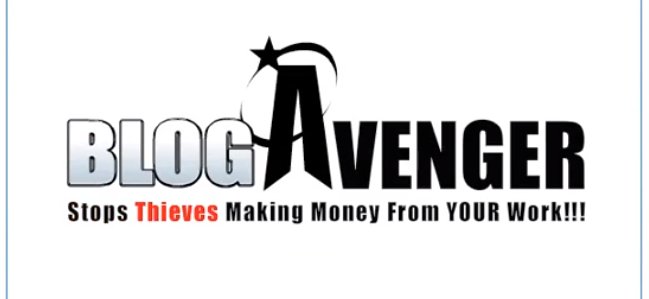BlogAvenger: Does Your Blog Content Need an Avenger?
 When it comes to protecting and tracking content one, most blog authors have a very simple problem: There’s just too much of it.
When it comes to protecting and tracking content one, most blog authors have a very simple problem: There’s just too much of it.
Even if you just write a blog post twice a week, that still results in you having over 100 entries by the time you reach your one-year anniversary. If each blog post is just 500 words long, which is fairly short, that means you have 50,000 words of content to track, monitor and enforce if you want to catch it all.
As a result, most bloggers, if they track their content at all, look primarily at their static content (the pages that don’t change), the most recent posts and, sometimes, the most popular ones historically. While this can still be a great deal of content, it’s a much more manageable amount.
However, a new plugin for WordPress aims to address that issue. It’s called BlogAvenger and it aims to make it so that you can track all, or nearly all, of your blog’s content.
I was given the opportunity to test out BlogAvenger during its beta phase and am continuing to use it now on this site.
Does it work and is it worth the money? I’ve got a thorough overview and review for you below….
What is BlogAvenger
BlogAvenger is a plugin for self-hosted WordPress installations (version 3.5 and later) that does four separate things:
- Disables text selection on the site.
- Automatically watermarks images so, if they’re reused, they will carry your site’s information.
- Scans for matches of your blog’s content and, when found, automatically generates DMCA notices that you can send.
- Bans IP addresses of known scrapers, either blocking them or feeding them a promotional ad for your site.
BlogAvenger is installed pretty much like any other plugin. Though it’s not available from the WordPress plugin repository, you can easily download the zip file and upload it to your installation. However, it’s important to note that your server needs to have IonCube installed. Many shared hosts have Ioncube already installed but, in my case, I had to install it on my hosting account before I could get the plugin to work.
Once installed and running, you’ll need to enter your license ID Number. You can either get a paid “Pro” version, which is currently $29.00 for a lifetime license, or use the free version. The main difference is that the free version will not generate/send DMCA notices nor will it let you hide the “Protected By” footer.

Once you have entered your license number, you’ll then be able to play with the options as you see fit, including whether or not to watermark your images and what content to look for. Specifically, you can tell it the threshold for alerting you to infringements and when to stop tracking old posts (BlogAvenger can look at up to 3 years of posts).

From there, the plugin is pretty much “set and forget”. You’ll receive emails as BlogAvenger finds new content. You can exclude posts from BlogAvenger checks by simply ticking a box in the “Add New Post” screen and you can also exempt images from watermarking by adding “nowater” to the filename.

The question though, is does it work? The answer seems to be well enough.
Thoughts on BlogAvenger
Overall, after over a month of testing, I’m pleasantly surprised by BlogAvenger. Having used and tried many “content protection” plugins, this appears to be one of the first that actually does a good deal to help.
To be clear, some of the features aren’t particularly impressive. For example, the feature that lets you disable text selection is, more or less, a waste of time that will just frustrated legitimate users.
Also, I didn’t test the watermarking feature in BlogAvenger. Though I was promised the process was reversible, I didn’t want to tax my server by having it watermark the thousands of images that have appeared on the site, especially since I only own a tiny fraction of them (most pulled from stock photo sites).
Basically, the watermarking feature is only useful for either new sites that can start out using the “nowater” indicator or sites almost entirely made up of original images.
However, those features aren’t the real star of the show. The content tracking, DMCA preparation and anti-scraping tools are the real reasons to be interested in BlogAvenger.
Those features, for the most part seem to work well enough. Shortly after I got set up, I started receiving alerts on posts of mine that were appearing elsewhere. Though many of these alerts were unnecessary, simply telling me about people who have used my content in compliance with my Creative Commons License, it did alert me to other problems, including the recently reported issue with MailChimp making my content available in Google.
Still, there were a few quirks with it. For one, BlogAvenger sent me alerts on comments posted to the site, not blog posts. Second, some of the pages reported were not working, even though I checked them almost immediately after discovery and, finally, the content matching wasn’t always perfect as, even though I specified only matches larger than 50%, I couldn’t always find the infringing material.
The latter is because BlogAvenger does not do any content highlighting on the matching pages, meaning it can be something of a hide and seek game to find the allegedly infringing material, depending on the site.
Moving on to the DMCA notice service, the generated notices are legally sound. It’s very convenient to have the notice automatically created for you (with your information already filled int) and BlogAvenger does offer to send them for you directly in the plugin (Note: It will only send notices you approve).
However, this feature falls down a bit when trying to decide where to send the notice. As you see on the “Finding the Host” page here, the process of finding a good DMCA contact is often difficult. BlogAvenger seems to pull its information from the DNS information from the site and, as a result, makes a lot of mistakes.
For example, once BlogAvenger correctly identified a site as being on Softlayer but suggested I send the notice to their abuse@ account even though Softlayer’s DMCA agent is copyright@. Though the former likely would have been fine, I would expect many of the notices sent to BlogAvenger’s generated email addresses to fail due to these kinds of errors.
Finally, it’s worth noting that the feature to block known scrapers does not work particularly well. It functions by banning the IP addresses of known infringing sites but the IP address of the scraper bot is often different than the IP of where the content appears, making the ban ineffective. While it likely stopped some simple scrapers, many sites that were “banned” were able to continue with immunity.
But while this might seem like a very negative review, the truth is that BlogAvenger did a decent job tracking a volume of content I could never hope to do by hand and, in the process, alerted me to problems that I was not aware of. Even if it wasn’t 100% accurate in finding the content or pointing out who to send the notices to, it still did more than I (or any human) could have hoped to have done by traditional means.
BlogAvenger Recommendations
So is BlogAvenger right for you and, if so, which version should you use?
First off, you should make sure you meet the requirements. As mentioned above, you’ll need a self-hosted WordPress blog and support for IonCube. If you are unsure if you have support for IonCube, you’ll likely want to ask your host before downloading the plugin.
If you can install it and you are interested in tracking your content, whether for enforcement or just to see where it winds up, BlogAvenger is a very powerful tool. It makes tracking nearly all of your blog content very easy, more or less set-and-forget, and, aside from a few bugs, works extremely well.
I would not trust the DMCA service blindly. I would encourage you to find the DMCA contact on your own and copy/paste the notice into your email client to ensure delivery. I also wouldn’t encourage you to rely on scraper blocking but it is a nice addition and it may help catch some.
As far as which version you will want. Both the free and the paid offer the content tracking. So, if you don’t want help sending DMCA notices and don’t mind the badge at the bottom of your site, then the free one should be fine. On the other hand, $30 for a lifetime license per blog is a very good deal, considering similar services charge monthly, it’s probably worth the upgrade costs for most bloggers.
Still, I would recommend most bloggers who are interested to try the free version first (unless they absolutely can’t stand having the badge on their site). If it works well for you, it’s trivial to upgrade later and, if it doesn’t, it’s easy to uninstall.
Bottom Line
When it comes to blog protection schemes, BlogAvenger is something of a rare bird. It’s a content protection system that actually helps protect content.
While it may not find every infringement out there, it will alert you to ones you did not and could not have known about otherwise.
The only real issue I have with BlogAvenger, other than the features that don’t work as well as advertised due to technical limitations (there isn’t much of a way they can work), is the design of it.
BlogAvenger is, in a word, extremely utilitarian and is neither nice to look at nor extremely easy to use. While most options are self-explanatory and help is nearby, many bloggers are going to feel intimidated by the current look and feel, even if they shouldn’t.
But if you can get past the technical requirements and the interface, BlogAvenger is a plugin well worth trying.
Disclosure: For help in beta testing, I was given a free BlogAvenger Pro account, I used that account as the basis of this review.
Want to Reuse or Republish this Content?
If you want to feature this article in your site, classroom or elsewhere, just let us know! We usually grant permission within 24 hours.
